SEARCH
SIGN UP FOR UPDATES
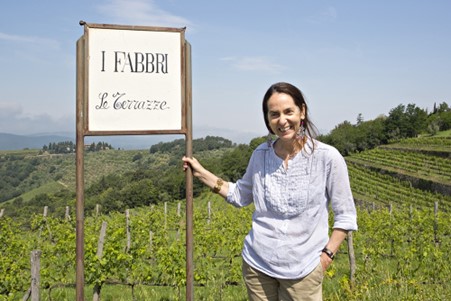
I Fabbri
Dylan’s Travels to Chianti
What a night at I Fabbri. I had to do some serious rally driving to arrive at all. It had been a long four and a half hour drive from Cantinarte in Abruzzo. The last half or particularly 20 minutes was challenging. The tarmac ran out, the mist was down and it was raining. I was aware I was going to be late having not expected the conditions or the twisting, undulating forest track.
Arriving at I Fabbri
I finally arrived at the little square where Susanna had told me to park. With no visibility I had little idea which way to go into the mist: up, down, north, south, east or west! A forester in a Land Rover emerged and offered for me to follow him. He indicated for me to turn down a narrow track and I finally arrived at the Castello di Lamole.
The Wine Maker-Importer Relationship!
Susanna was waiting and directed me into a little parking space. We hugged like old friends, but we have only met briefly maybe three times! Is it because of the product you have been selling for years that means you feel like such old companions? In the same way as when you meet old college friends and you can pick up again at the drop of a hat we chat away!

She led me up some stone steps to a beautiful compact tasting room. On another day I’m sure it would have had a spectacular view over her treasured vines.
She had left a successful career in fashion in Florence more than 20 years earlier to come and resurrect her family’s vineyard. This is a family history she can trace back 400 years. I-Fabbri (blacksmiths) maybe attests their former graft in the north of Italy but surely four centuries of lineage is enough for a family to claim roots.
Tuscany
The vineyards are some of the highest in Tuscany, really not too far from Florence, maybe 35 kilometres (which even in the day could take a heroic hour or more in a motor car on a night like tonight). But tonight, as the light outside faded, I might as well have been visiting a vineyard in the depths of Armenia or Moldova or halfway up the Catalan Pyrenees!
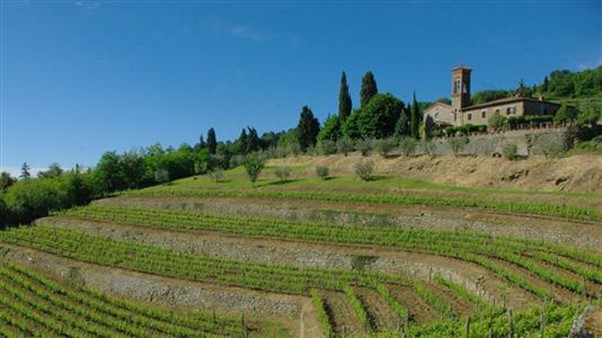
The Tasting
Two tables were set – one had glasses and three bottles of Suzanna’s labours and hard to ignore was another with two place settings bowl and dinner plates, neat napkins, more glasses. I would not starve before losing myself in the forest later!
We tasted through her different cuvees as she explained the nuances between them. The bedrock of Tuscany and Chianti is Sangiovese and make up the majority of her wines – bar one. A little proportion of Caniolo here, 20% Merlot in the Olinto giving a hint of plumper fruit and one cuvee of Merlot from vines she planted before 2000 as she re invigorated her ancient family fields and terraces of vines.
Lamole Chianti Classico
100% Sangiovese Grosso come from the highest vines up to 630 metres (most of the way up our local mountain Cader Idris as I look out from my kitchen in Dolgellau now). Aged in cement tanks for 12 months. ‘Cement’ just doesn’t sound so romantic but is the bedrock of some great wines. I find age and experience tend to cool the enthusiasm of wine makers for oak (once again awarded Tre Bicchieri in the prestigious Gambero Rosso Guide).
Terra di Lamole
This wine has the addition of 10% Canaiolo grapes from lower vineyards (down at 550 metres!) and some from her oldest vines planted around her birth in the 1960s. Here there is some use of oak a proportion spending time in 500 litre French oak barrels.
Riserva Chianti Classico
The Chianti is all made in 500 litre French Tonneau, the 2020 for around a year. This use of not new oak is about giving texture to the wine and for sure rounding the flavours.
Grand Selection Sangiovese Grosso
The Grand Selection Sangiovese Grosso is from some of the oldest vines. It is only made in the best years and is aged in 1500 litre Allier tonneaux for 24 months. This is the highest representation of what those 60-year-old vines can do.
“Il Doccio” 2018
This finished off the tasting. It is 100 % Merlot and demonstrates what restraint in the high hills of Lamole can produce. It is delicious but not overblown.
Susanna is erudite, modest and charming – her wines reflect this. They are powerful but not blockbusters where impact is impressive but whose pleasure may wane. With the wines of I Fabbri the pleasure grows. The complexity reveals itself: the fruit is there, the acidity is there, the tannins too. It is the balance that makes these wines so good.
And the Socialising!
So back to the other table. Hospitality in Italy comes hand in hand with my work that is wine but so often food makes the experience so special. I follow her down another stone staircase to the kitchen below. A simple meal is ready to throw together. We break bread together, literally – crunchy croutons to scatter into the delicious potato and pumpkin soup, drizzled with a little fine olive oil. Now we relax and conversation can spread to how much olive oil one might use in a week (one litre for a family would be normal). Politics and the state of the world however horrible seems more bearable with some simple meatballs in tomato sauce and small diced fried potatoes garnished with rosemary and of course a glass of I Fabbri in hand.
Lost Again!
Such an experience would make any job worthwhile. I have to say it is not always so, but this is a visit to stay in one’s memory for years. The time has flown and I am late to reach my accommodation. Susanna wrapped up the slice apple tart for me to take with me. She phones the hotel to say I am on my way and will be there in good time. We go back out into the dark, mist and drizzle and hug like the old friends we now are! She gives me the sort of directions that are vital to get me straight to my hotel: left at the end of the track, right when you get to the bottom of the hill and right again by the pharmacy in the village. Instructions that seem so obvious immediately, but sadly half an hour later I’m now further from my bed than when I left her! Eventually I have headed up and over some strange mountain (Chianti is hilly) and I arrive at the hotel. A light is on, a little envelope on the doorstep with my key and directions to my room. I slept so well!
Click HERE to see her wines on our website.
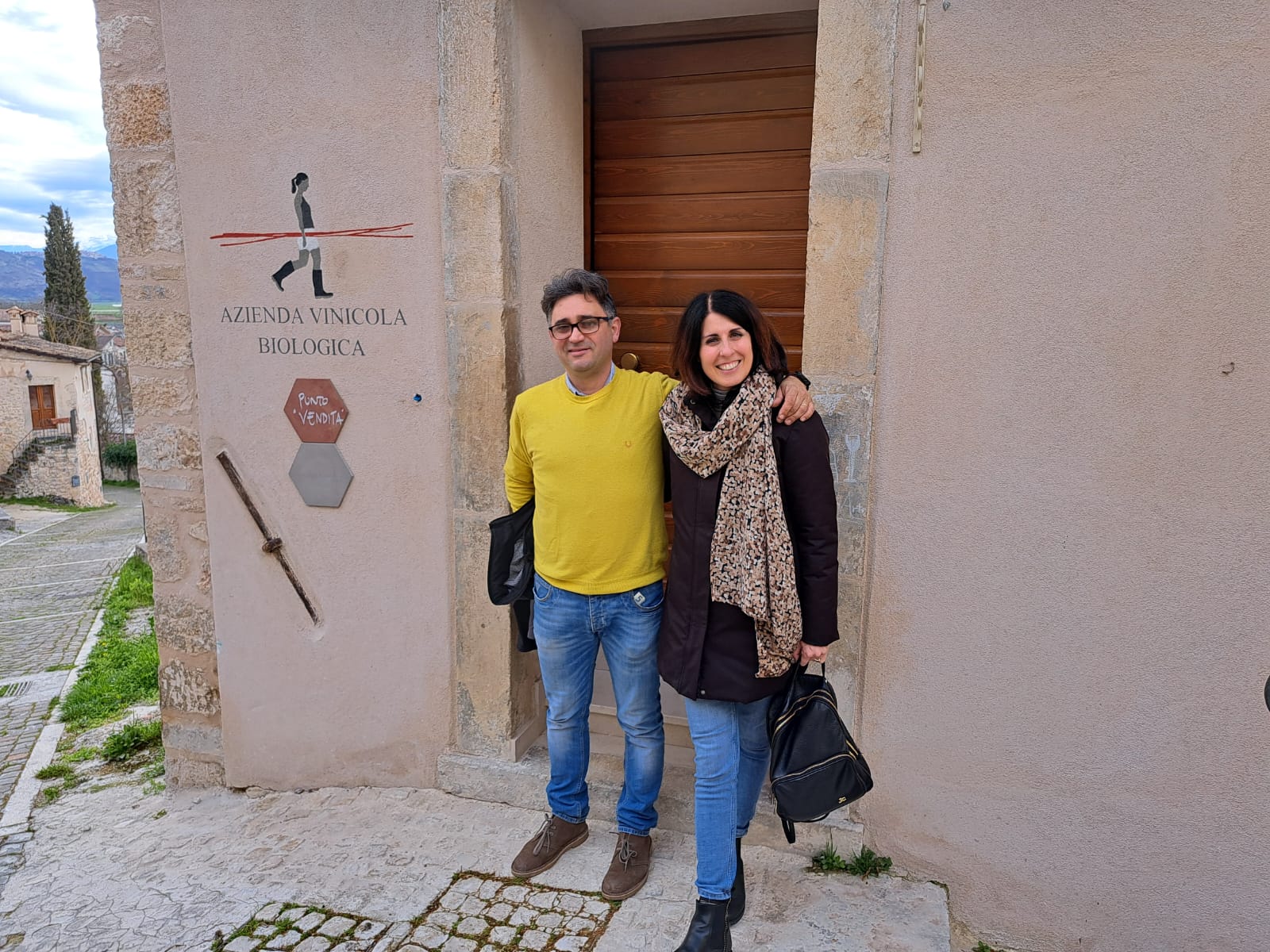
Cantinarte
I was on my way to Cantinarte – an epitome of a family run business in Abruzzo, central Italy. They are all immersed in this beautiful winery: her father checks the vines and the quality of the grapes every day and harvest is very much a family affair. They hand-pick and personally select the grapes for the very best quality in Cantinarte. We started buying from Francesca a few years ago and I am reminded why. Her respect and commitment to the land and itssustainability is unquestionable. This is farming at its best.

Finding the Vines!
Now sometimes it is just not what you expect. Oh yes, I knew I would have a wonderful warm welcome from Francesca and her husband. The tasting was already laid out for me and of course there was food afterwards – a simple and delicious soup of beans and vegetables typical for the area. Cheese and salami followed – the salami a particular speciality of the South of Abruzzo. But where were the vineyards?
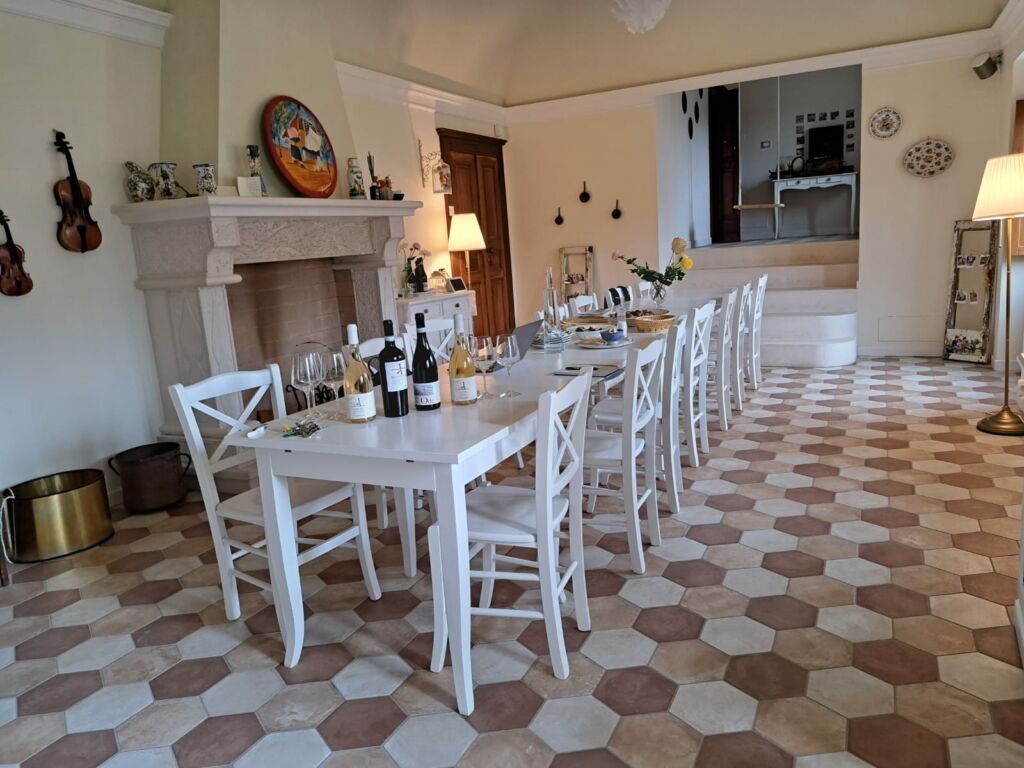
A Beautiful Landscape
Having driven through the mountains to Navelli, the small village clinging to the hillside, I had not yet seen a single vine. Where do they make their white wine? All was revealed as we drove across a muddy field to see the two-hectare vineyard hidden behind the village. Strong protective fences have been erected to keep out the wild pigs and deer! Immaculately trained, at this high altitude they produce wonderful white wines from pecorino and pinot gris grapes.
Worth the Trip
The Reds that are so good come from lower down the valley around the hilltop Roman city of Chieti and are powerful expressions of those typical Montepulciano grapes. Don’t take my word for it, as soon as I returned, we put them in the pods for you to taste! They will be there for another week or so, or click here to see our present online selection.
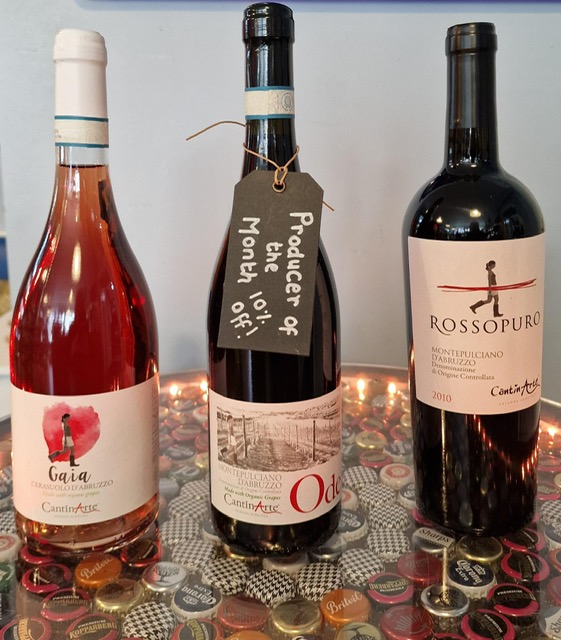
Take a Break in Italy!
You can also go and stay in this very beautiful area, Francesca not only produces her own organic wine, but also olive oil. You can also organise food activities! I would highly recommend it with a visit to Cantinarte’s historic olive oil museum.

The Italian Tour
The Italian Tour
How exciting it was to set off on our first training trip to some of the vineyards that Gwin Dylanwad Wine import from. The Italian tour promised some serious training and I was looking forward to it. We set off early on Sunday morning and landed in our accommodation at the foothills of the Dolomites late that night.
I know a lot of people are saying it’s a cushy number being taken off to visit vineyards but it was actually a lot of travelling. Without fail, every wine maker we visited expressed shock at how far away we were staying (about 45 minutes). It was a lot of driving but the experience of travelling through the Italian countryside was worth it and the views were spectacular. And in Wales, we are used to travelling! It was also a good opportunity for a bit of team bonding.
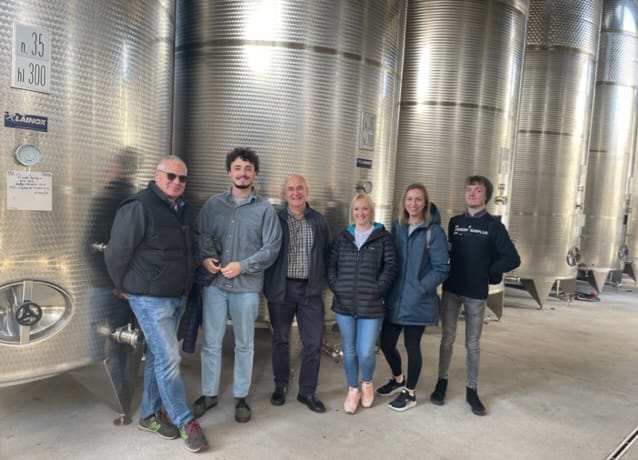
The Italian Tour – Bidoli
Bidoli was a very smart winery. I was very impressed by the quality of the Pinot Grigio. This is the type of wine that I have found bland and uninteresting in the past. Bidoli’s was brimming with lovely stone fruits balanced with a good acidity and was very refreshing. It was a prime example of a well-made easy drinking wine.
I was struck by the welcoming and kind hosts of these vineyards who were so passionate about their company. Even if they didn’t own it, they were so enthusiastic about showcasing their product to the world – even a tiny company from Wales. As a result, we were wined and dined quite lavishly! Excellent food coupled with lots to drink and an absolute overload of education!
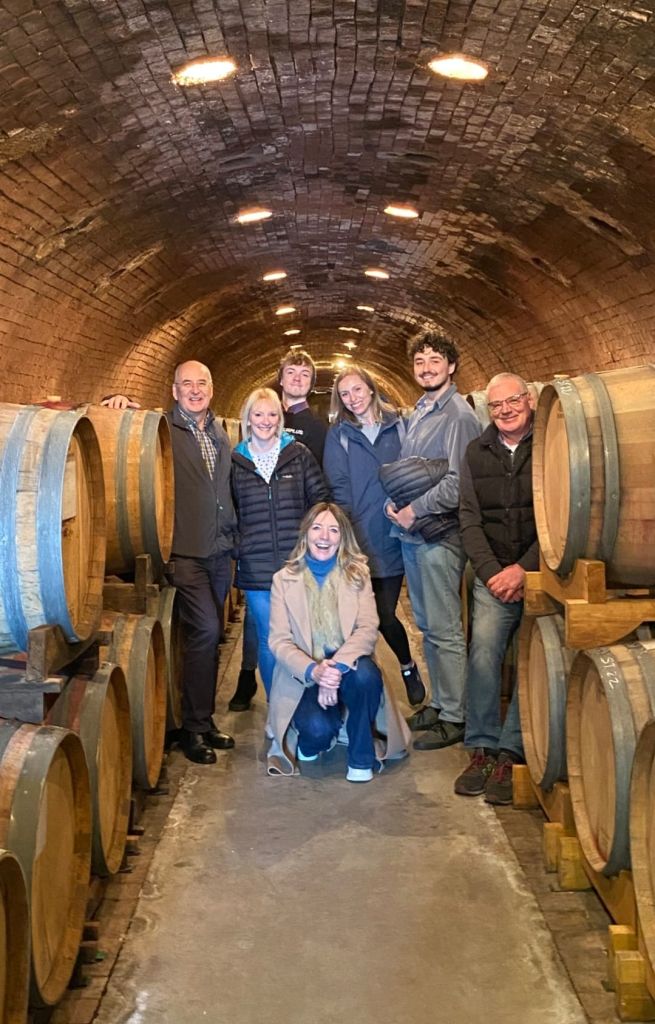
Perlage Winery
I really appreciated the organic practices of Perlage, especially while growing their grapes in Valdobbiadene for their Prosecco Canah. They use local compost and no pesticides. The steep slopes in this area are very impressive and are key to the production of top Prosecco. It was very interesting to be able to work through the 3 stages of the Canah. So we were able to taste the juice of the grapes before fermenting from one tank, then the wine after the first fermentation and the final product.
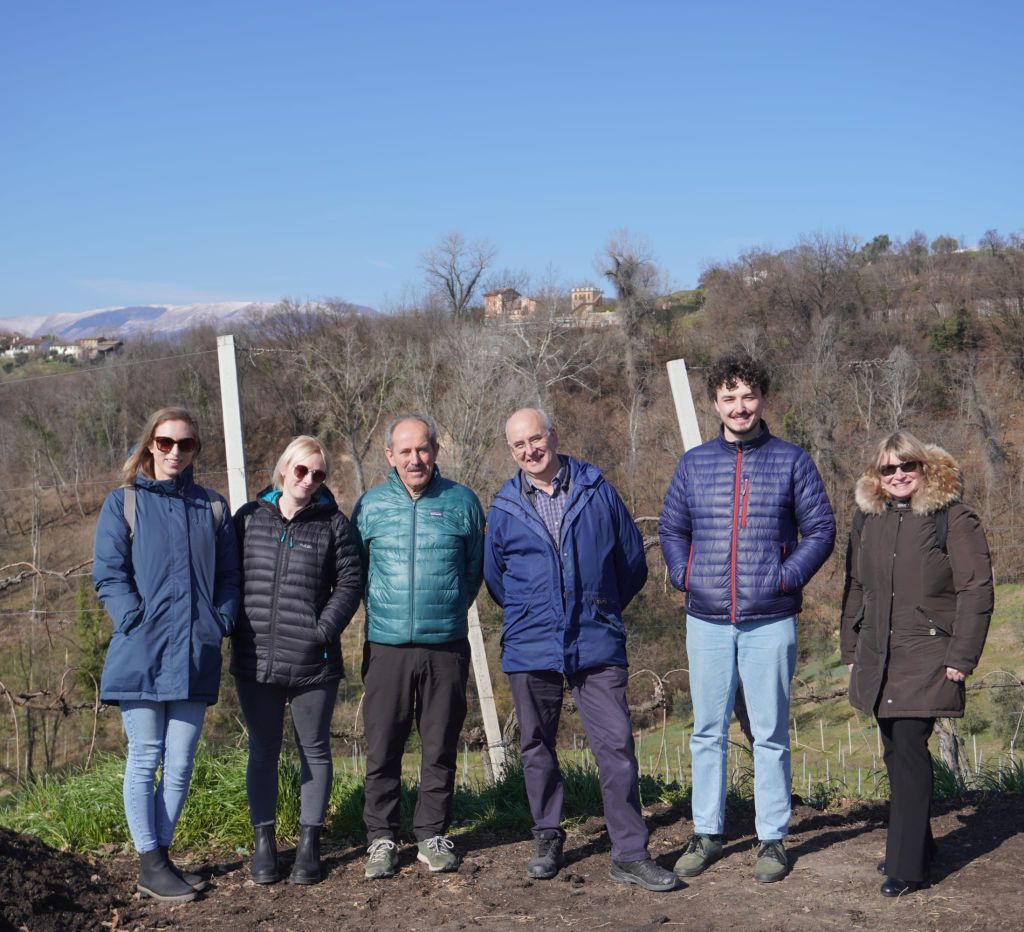
Special Italian Imports
So why not give these delicious wines a try? Have a look at Perlage on our website or Bidoli. I think the Perlage Sangiovese is a lovely smooth easy drinker and the Bidoli Pinot Grigio delle Venezie will change your mind if you think all Pinot Grigio is bland! Enjoy!
Osian
